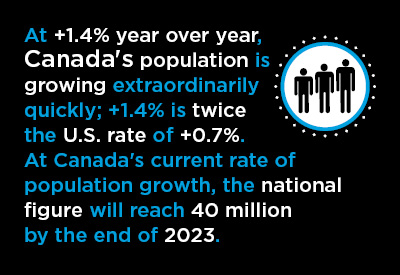Statistics Canada’s latest national and provincial/territorial population estimates are for October 1, 2018. The two tables included with this article and the 15 bullet points below throw a spotlight on many of Canada’s most recent demographic highlights.

- At +1.4% year over year, Canada’s population is growing extraordinarily quickly; +1.4% is twice the U.S. rate of +0.7%.
- Canada’s nominal resident increase in the latest 12 months was +530,000 people, equivalent to a new city the size of London, Ontario, in just 1 year.
- At Canada’s current rate of population growth (+1.4% y/y), the national figure will reach 40 million by the end of 2023, only five years from today.
- If the current rate of population growth is maintained long-term, Canada will climb over 50 million 2040.
- The three provinces with population growth speedier than the +1.4% total Canada rate are: Prince Edward Island, +2.2%; Ontario, +1.8%; and Alberta, +1.6%. Among all provinces and territories, Nunavut is fastest of all, +2.3%.
- While Alberta is still experiencing noteworthy population growth, there has been considerable deceleration from earlier. Four times in the past ten years, Alberta has seen annual population growth of more than +2.0%. The peak occurred from 2012 to 2013, at +2.8%.
- P.E.I.’s population has been increasing by more than +2.0% annually for the past three years.
- B.C.’s population just reached the 5 million level. The province’s next major milestone will be 6 million by 2040.
- Ontario’s population, at its current rate of advance of +1.8% annually, will reach 15 million by the end of 2020; 20 million by 2037; 25 million by 2050.
- Immigration accounted for 60% of Canada’s total population growth in the latest 12 months.
- Ontario has usually welcomed about 1/3 or 33% of immigrant arrivals each year. In the latest 12 months, Ontario’s share soared to 44%.
- Quebec is in second place among provinces and territories as an entry point for immigrants, with a share of 15.7%.
- By a significant margin, Ontario picked up the most residents through net interprovincial migration in the latest 12 months, +18,336. There were three other provinces with interprovincial net gains: B.C., +5,474; Alberta, +4,821; and Nova Scotia, +2,429.
- In the latest 12 months, Ontario’s population has risen by +1.8%, or +260,000 people; +260,000 is equivalent to a new city bigger than Barrie in just 1 year.
- In the latest 12 months, Toronto CMA’s Population has climbed by +2.0%, or +120,000 people; +120,000 is equivalent to a new city the size of Peterborough in just 1 year.
- Montreal’s population is increasing by about 50,000 per year; Vancouver’s, by +30,000.
Also view, "Infographic: Canada’s fast population growth".
Table 1: Canada’s Latest Population Statistics − Level & Change
| Share of Canada, | Oct 1 18/Oct 1 17 | Oct 1 18/Oct 1 17 | ||||||||
| Oct 1, 2017 | Oct 1, 2018 | Oct 1, 2018 | Nominal Change | % Change | ||||||
| Nfld & Lab | 528,463 | 525,073 | 1.4% | -3,390 | -0.6% | |||||
| PEI | 151,477 | 154,750 | 0.4% | 3,273 | 2.2% | |||||
| Nova Scotia | 954,374 | 964,693 | 2.6% | 10,319 | 1.1% | |||||
| New Brunswick | 768,212 | 772,238 | 2.1% | 4,026 | 0.5% | |||||
| Quebec | 8,329,664 | 8,421,698 | 22.6% | 92,034 | 1.1% | |||||
| Ontario | 14,153,806 | 14,411,424 | 38.7% | 257,618 | 1.8% | |||||
| Manitoba | 1,340,776 | 1,356,836 | 3.6% | 16,060 | 1.2% | |||||
| Saskatchewan | 1,155,034 | 1,165,903 | 3.1% | 10,869 | 0.9% | |||||
| Alberta | 4,262,642 | 4,330,206 | 11.6% | 67,564 | 1.6% | |||||
| B.C. | 4,945,559 | 5,016,322 | 13.5% | 70,763 | 1.4% | |||||
| Yukon | 39,781 | 40,333 | 0.1% | 552 | 1.4% | |||||
| NWT | 45,097 | 44,445 | 0.1% | -652 | -1.4% | |||||
| Nunavut | 37,773 | 38,650 | 0.1% | 877 | 2.3% | |||||
| Canada | 36,712,658 | 37,242,571 | 100.0% | 529,913 | 1.4% |
Table 2: Canada’s Population − Interprovincial & Foreign Migration
| Interprovincial | Immigrant Arrivals | Immigrant Arrivals | ||||
| Migration | Latest 12 Months | as Share of | ||||
| Oct 1 17 to Oct 1 18 | Oct 1 17 to Oct 1 18 | Canada Total | ||||
| Nfld & Lab | -3,698 | 1,397 | 0.4% | |||
| PEI | -322 | 2,155 | 0.7% | |||
| Nova Scotia | 2,429 | 5,678 | 1.8% | |||
| New Brunswick | -510 | 4,349 | 1.4% | |||
| Quebec | -5,954 | 49,392 | 15.7% | |||
| Ontario | 18,336 | 137,604 | 43.6% | |||
| Manitoba | -9,678 | 14,285 | 4.5% | |||
| Saskatchewan | -9,862 | 15,246 | 4.8% | |||
| Alberta | 4,821 | 40,655 | 12.9% | |||
| B.C. | 5,474 | 44,117 | 14.0% | |||
| Yukon | -73 | 280 | 0.1% | |||
| NWT | -1,120 | 272 | 0.1% | |||
| Nunavut | 157 | 34 | 0.0% | |||
| Canada | 0 | 315,464 | 100.0% |











Recent Comments
comments for this post are closed